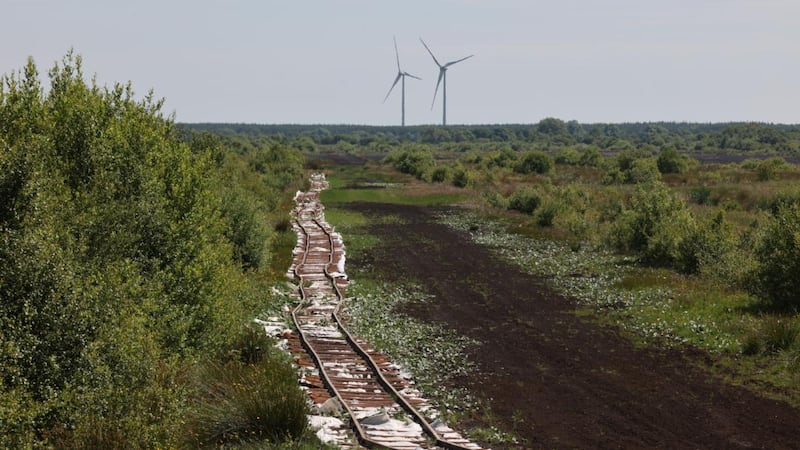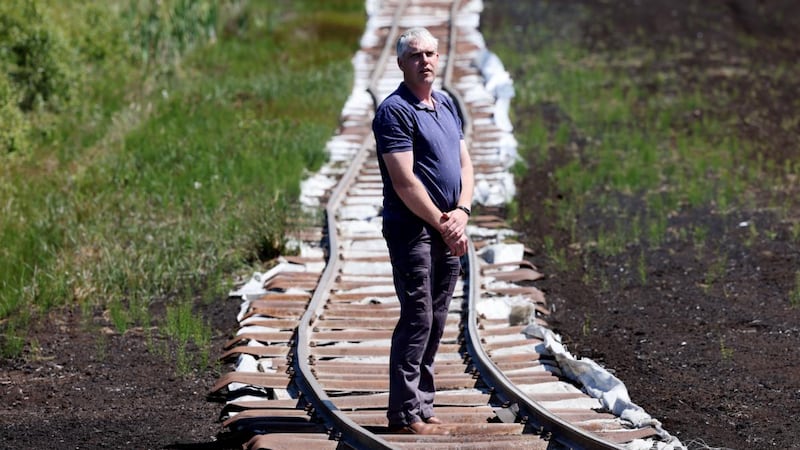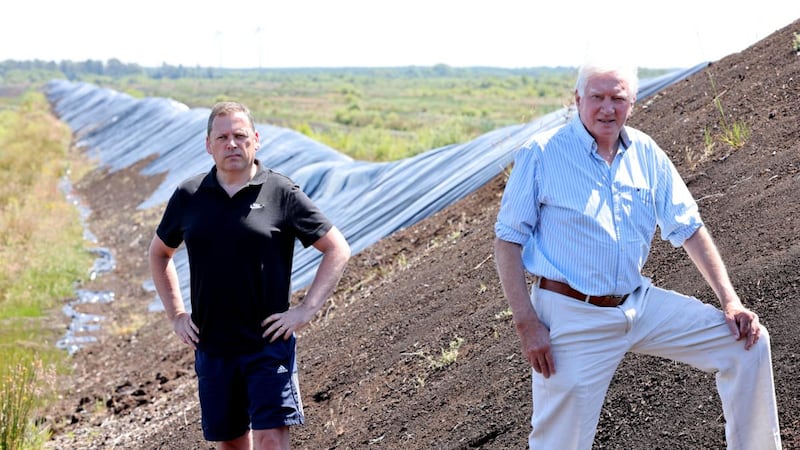On a corner of Falsk Bog in Co Offaly, on a breathless day with an unsparing sun, three figures stoop over a huge rectangle of neatly laid out sods. Mick Dooley, his nephew Conor, and Ursula Fischer (a visitor from Switzerland) work their way through the brown grids methodically, footing the turf into Jenga-like mounds so that the peat will dry. It's back-breaking work but they work in a fast rhythm despite the searing heat. Two farm dogs happily flit in and out.
Dooley has a farm on the edge of the bog. He is a sinewy man, good-humoured and chatty. The landscape here is astonishing, like nowhere else in Ireland. The flatness stretches as far as the eye can see to the north and west and to the Slieve Blooms in the south.
“Big skies,” observes Dooley. He is right. This brown landscape looks more like north Dakota than Ireland. “We are so used to it that we take it for granted,” he says. “People who don’t have this think it’s amazing.”
The group is happy to have their work filmed. “It’s good to get a record of it before it’s gone,” says Dooley.
He may be referring to the ancient tradition of footing turf but, in reality, everything to do with the great midlands bogs, is essentially gone, or hanging on by its fingernails. A generation ago, the 600-acre bog behind him would have been full of workers, huge industrial machines, narrow gauge freight trains, harvesting and collecting peat for the two local power stations at Shannonbridge or Ferbane, or for the briquette factory.
Now it lies idle, a vast and fallow brown desert stretching out as far as Clonmacnoise to the northwest. On the other side of the road is Noggus, another large bog. It's now a cutaway bog, without any residual peat – skeletal remains essentially.
In its heyday the great energy semi-State Bord na Móna employed 8,000 people across 80,000 hectares of bog in the midlands, straddling nine counties. It harvested the peat on an industrial scale. The peak of extraction was 6 million tonnes in 2013. Towns in Offaly, Longford, Roscommon, Laois, Westmeath, Tipperary, Meath and Kildare and Mayo existed because of it.
"Shane Lowry, the great golfer and British Open champion, his grandfather came back to take a job here in Ferbane power station. That is the impact it had at that time," says Barry Cowen, a Fianna Fáil TD for Laois-Offaly.
Eamon Dooley is a former Bord na Móna worker and a local councillor. In 1936 Ferbane was little more than a hamlet with a population of 300, he says. By 1956 with the coming of Bord na Móna, and the ESB power station at Ferbane, the population had risen to 900. Now it is 1,285.
It sustained Eamon Dooley too. He started work on Falsk bog at the age of 16 in 1970 and remained with the company until his retirement. “It was a great employer,” he said.
Now he stands on Falsk Bog. The only glimpse of its past is a plastic covered ridge in the distance. This represents the last stockpile of peat destined for the briquette factory. When the stocks run out in 2023 or 2024, that will be it.

Why the sudden demise? The company had originally said it would cease peat extraction by 2030, and then by 2025. The ESB said more or less the same of its two peat-burning power plants in Shannonbridge, Co Offaly and Lanesborough in Co Longford. But then in the summer of 2019, An Bord Pleanála refused permission to the ESB to convert Shannonbridge as a co-firing biomass plant, citing concerns over biodiversity and climate change. The decision triggered a rapid shutdown of the entire industry.
Today, there is also a glimpse of the future on Falsk Bog. In the distance stand two giant wind turbines, their blades revolving slowly against the blue sky.
An hour away at Bord na Móna headquarters in Newbridge, Co Kildare, a full rundown of that future is unveiling. The company’s chief financial officer JP McGrath, a Tyrone native with a calm manner, explains the gestation of the company’s new direction. It invested in its first wind farm as far back as 1982, he says, but it is only in recent years that it accelerated towards renewables. The An Bord Pleanála decision was the turning point. Almost overnight, Bord na Móna turned from being poacher to gamekeeper.
‘Brown to green’
“We introduced this brown to green strategy, which really was the framing of that transformation,” says McGrath. “It’s actually evolved even further since then, and we’re now looking at ourselves as being leaders in decarbonisation.
“So it’s not just about moving the business from brown to green, it’s about helping Ireland to achieve its net zero goals for 2030 and 2050 and beyond.”
That future is renewable energy, mainly wind but also solar. There is also recycling and, more recently, rehabilitation of the very bogs which it denuded. But primarily it is clean energy.
McGrath says it has a pipeline of 15-20 renewable energy projects over the next 10-15 years. Its lodestar is the massive windfarm at Mount Lucas. Over this decade, hundreds of turbines will be erected on the spent bogs. Eventually, says McGrath, Bord na Móna will be providing enough energy for one third of all Irish homes. Already its pipeline is valued at €1 billion.
When the closures came, news reports talked about the loss of 2,000 jobs. Bord na Móna has always maintained this was never so. Nobody was fired. Some retired or were given voluntary redundancy. Others were redeployed. The Government provided funding of €108 million to Bord na Móna for a large-scale peatlands restoration project. McGrath says it will create 1,000 new jobs – and still employ 2,000 – by the end of the decade.

The jobs in energy and rehabilitation will be all high-end, says McGrath at degree or post-degree level: ecologists; engineers; renewable energy specialists.
There will be no net loss.
So what’s the problem then? There is a glitch and it is this. For some Bord na Móna workers, too young to retire, too old to be retrained, they feel they have been left high or dry. And while new jobs will be created they will be elsewhere in the midlands, not in towns like Ferbane which has depended for its existence on the bogs.
Local decision-making
Declan Killian is a seasonal worker who transports the milled peat by rail wagon from bog to briquette factory. "For someone like me in my late 30s, I have been there since 2003 and have built a house and have a family.
“I’m at an age where there’s no job to go to here and it’s too late to move away. Just transition has been promised. We have not seen it yet. Environmentally friendly things, that’s the way the future is. But to me, there is no employment in windmills and solar panels.”
Eamon Dooley takes up the theme. “Everybody would agree with reducing greenhouse gas emissions and we can’t argue with that. The debate is about how it’s happening and is managed.”
For him there are two problems. The Government announced a just transition fund of €27 million. Soon a further €77 million will come from the EU for the same purpose. But he argues the two places that were most affected (Longford and Offaly) shared it out with seven other counties, much less impacted.
“This thing of keeping everybody happy and one for everybody in the audience is not going to work. This has to be targeted for Longford and Offaly where the job losses are.”
For Barry Cowen, there will be few Bord na Móna jobs in Ferbane and other “bog” towns. He says the new jobs will need to be totally different. He cites the closure of the Ferbane power station 20 years ago. Then the ESB provided a €3 million fund. A local community company was formed and a business and technology park founded which has created 70 jobs in food, manufacturing, technology and services.

He said the current €27 million funding for just transition should follow that example, with local decision-making and less of the bureaucracy and red tape that has made it difficult for local enterprises to tap into the funding.
“Decisions are taken by department staff rather than local groups in conjunction with the local authority. This should leave us coming out of the process far better than we went into it. That has not been the case.”
Liam Cullinan, who is with the ESB group of unions, says the company gave €5 million to the Just Transition fund this time around and is concerned it will go elsewhere than Offaly and Longford.
“We need new business in this area to take over the mantle of the ESB and Bord na Móna. Until we get that it’s very hard to see how the youngsters around here at the moment are going to stay around.
"You can see them going to Dublin, Galway and Limerick and not coming back."
These local people argue that jobs in constructing turbines and rehabilitating bogs will be temporary rather than sustainable and long term.
In a decade’s time, says Cullinan, Falsk Bog will be full of wind turbines but will provide little employment.
Bog railways
There is some tourist potential. On the bonnet of his car, Eamon Dooley pores over a map of the region and traces out with his finger the connected bog railways criss-crossing the whole of the midlands. They amount to hundreds of kilometres. The farmer, Michael Dooley, tells you it's the biggest privately owned narrow gauge railway in the world. That, he says, gives it huge potential. Already there are visitor attractions at Lough Boora and at Mount Lucan. Still, Eamon Dooley is unsure if tourism will fill the void left by Bord na Móna.
Pippa Hackett is Minister of State for Land Use and Biodiversity and lives in Co Offaly is far more optimistic about the future. A Green Senator, she juggles principle with pragmatism on these issues. She acknowledges there will be some difficulties and some teething problems, but says the upsides greatly outweigh the downsides.
“Bord na Móna and the bogs have sustained economic activity here for many, many generations. We now know how much damage that has caused our atmosphere. We need to look after [the bogs] now.
“Bord na Móna is moving from brown to green, that’s going to be the future. We want to invite people back. We need to get that return and create good and clean jobs.”
Hackett points to the €108 million in Government money to rehabilitate and rewet 33,000 hectares. She candidly admits some bogs are so degraded they may not be possible to restore, and these will not be easy wins in creating carbon sinks.
“Those that are less degraded there is potential there to bring them back to their former glory. A degraded bog is a dead bog and simply rewetting is not taking it back to life. When you think about how long it took to create the bogs in the first place, we are not going to do this in a couple of years.
“If there is enough peat still there it’s worth rewetting because you stabilise the carbon for a start. Some bogs have been literally extracted to the marl. In those bogs you might think of planting. There are some trials to see that. It depends on how degraded the bogs are.”
She is upbeat about the future but acknowledges there have been wrinkles and delays in investment getting to affected communities. “There have been a few complaints about the slowness of the outlay. I accept that. Covid has not helped. Projects have been identified and once we see them in action we will get a real feel.”
She points to the potential gains: high-quality jobs with Bord na Móna; jobs in education; in ecology; in biodiversity, in engineering; in heritage and tourist attractions; in new community-led projects, in food, technology and energy.
“The innovation is there, we just have to harness that.”
A number of rural TDs have argued that the horticultural and briquette industries will have to rely on imported, less sustainable, peat. “That’s the carbon leakage argument,” counters Hackett, and the principle kicks in. “You get the same argument with beef and milk. At the end of the day we can only control what we do. We have made a commitment to decarbonise our country and we are going to have a just transition for the peat industry and the horticulture sector.”
“We ain’t going back,” she says with finality.


















